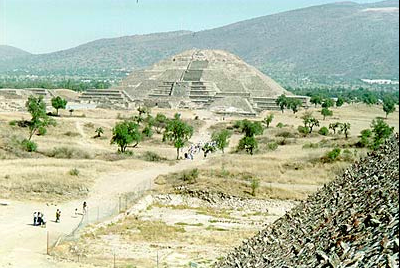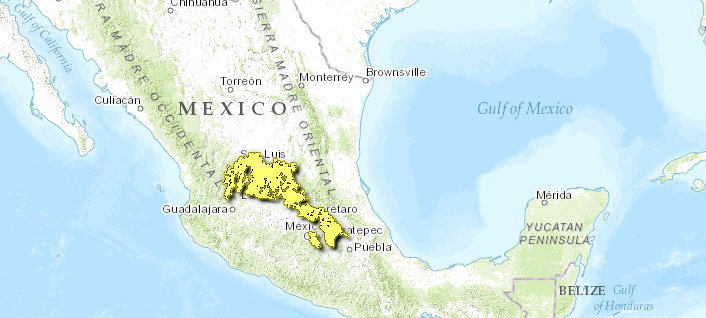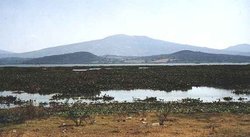Central Mexican wetlands
Introduction White pelicans (Pelecanus erythrorhynchos) Lake Chalapa, Mexico (Photograph by John Mitchell/Earth Images foundation (Central Mexican wetlands) )
This flooded grassland in central Mexico is characterized by aquatic vegetation such as Typha, and Cyperus. This ecoregion is an extremely important habitat for avifauna, more than two hundred species are found here. The entire area is considered an Endemic Bird Area; endemic species include the black-polled yellowthroat and yellow rail. The area also serves as a stopover for migrating birds. Much of the habitat remains intact although, deforestation of surrounding forest has lead to problems with erosion, which causes high sedimentation rates and an increase in salinity.
Location and General Description
The Central Mexican wetlands are a small set of lakes, rivers, and associated marshes and wetlands located in the middle of the rugged mountain range known as the trans-volcanic belt. Intense volcanic activity in the tertiary fragmented the Lerma-Santiago basin creating several lakes. In spite of their common origin, only lake Patzcuaro keeps most of its original characteristics. The climate is temperate subhumid with summer rains, changing to temperate humid in the south of the basin and high in the mountains.
The ecoregion is dominated by cattails and other reedy vegetation in dense stands over 2 meters (m) tall. Dominant wetland genera include Typha, Scirpus, Heleocharis, and Cyperus. The dominant species of aquatic vegetation are Potamogeton illionoensis, Scirpus pectinatus, tule (Typha latifolia), T. dominguensis and Nymphaea mexicana. In the watersheds surrounding the wetlands, the terrestrial vegetation is composed of xeric scrub (2,040-2,100 m above sea level), pine and oak forests intertwined with xeric scrub (2,100-2,400 m) and by pure pine-oak forests in the higher peaks (2,400-2,900 m).
Biodiversity Features
The ecoregion is extremely important for birds, in spite of its relatively small size. There are close to 200 species found here, including some endemics such as black-polled yellowthroat (Geothlypis speciosa), and yellow rail (Coturnicops noveboracensis), the latter not seen since 1964 and potentially extinct. Another endemic, slender-billed grackle (Quiscalus palustris), is now almost certainly extinct. The wetlands are also very important for resident and migrating waterfowl. The entire ecoregion is included in the Central Mexican wetlands Endemic Bird Area. Furthermore, there is an endemic amphibian, the Lake Putsucaro salamander (Ambystoma dumerilii).
In general, wetlands provide many important ecosystem services. They maintain [[humid]ity] levels, thus preventing long dry seasons. Wetlands also filter water and serve to recharge subterranean aquifers. In addition, many commercially important fish depend on wetlands at one or more of their life stages. Some fish species found in the wetlands include the hooded sawfin (Skiffia lermae), two Goodeides (Allophorus robustus and Goodea atripinnis), Neophorus diazi, and "pescado blanco" (Chirostoma estor).
Current Status
A large portion of the lake and surrounding area is in good state of preservation. However, a large part of the forests surrounding the lake have been logged. Cattle grazing has severely affected the scrub around the lake, which has led to accelerated rates of erosion that affect the processes of soil formation in the area. Water pollution in Patzcuaro is more or less severe; it is caused by human activities around the area and by the leather industry. Introduction of exotic fish like the black lobina (Micropterus salmoides) in the lake affects the ecological relationships among fish in this community: black lobina has displaced the native blanco fish (Chirostoma estor).
Types and Severity of Threats
Drainage of the lake is a serious threat because Patzcuaro is in the middle of an endorheic basin, thus its sole sources of refill is rainwater and the infiltration provided by the surrounding forests. Evaporation rates are larger than precipitation rates, a fact that makes Patzcuaro a fragile water body. Deforestation of the surrounding vegetation increases erosion, which in turn contributes to high sedimentation rates and an increase in salinity. These alter the natural regimes of nutrient exchange and plant-animal interactions. Drainage and erosion also contribute to increase the turbidity of water, to lower the amount of dissolved oxygen, and alter basic biological processes of fish and plants. The area is in need of a solid management plan to prevent the effects of pollutants, erosion, and introduction of [[exotic] species (Alien species)] in the aquatic environment. Rojas suggests the creation of an artificial water body near Patzcuaro, to introduce only native species and to restore the natural ecological processes of the aquatic communities of Patzcuaro. The collaboration between programs oriented to manage and preserve the pine-oak forests of the Trans-Volcanic belt and the wetlands of Michoacan will be necessary to reach the goals of biological conservation in the region.
Justification of Ecoregion Delineation
These wetlands of central Mexico are among the smallest of the Americas, and encompass critical habitat of several endemic endangered species. Linework for these small disjunct patches wetland follow INEGI classification of "Manglar/ Popal/ Popal y erosión/ Tular" in central Mexico. Linework was reviewed by experts during ecoregional priority setting workshops in Mexico.
Additional Information on this Ecoregion
- For a shorter summary of this entry, see the WWF WildWorld profile of this ecoregion.
- To see the species that live in this ecoregion, including images and threat levels, see the WWF Wildfinder description of this ecoregion.
- World Wildlife Fund Homepage
Further Reading
- Alvarez-Icaza, P., and C.Garibay. 1993. Producción Agropecuaria y Forestal. V. M. Toledo, P. Alvarez-Icaza, and P. Avila, editors. Plan Patzcuaro 2000 Fundación Friedrich EbertStiftung, Mexico D. F. ISBN: 9686823204
- Caballero, J., N. Barrera, and C. Mapes. 1993. La Vegetación Terrestre. V. M. Toledo, P. Alvarez-Icaza, and P. Avila, editors. Plan Patzcuaro 2000. Fundación Friedrich EbertStiftung, Mexico D.F. ISBN: 9686823204
- Chacón, A. 1993. Ecosistema lacustre. V. M. Toledo, P. Alvarez-Icaza, and P. Avila, editors. Plan Patzcuaro 2000 Fundación Friedrich EbertStiftung, Mexico D.F. ISBN: 9686823204
- CONABIO Workshop, 17-16 September, 1996. Informe de Resultados del Taller de Ecoregionalización para la Conservación de México.
- CONABIO Workshop, Mexico, D.F., November 1997. Ecological and Biogeographical Regionalization of Mexico.
- INEGI Map (1996) Comision Nacional Para el Conocimiento y Uso de la Biodiversidad (CONABIO) habitat and land use classification database derived from ground truthed remote sensing data Insitituto Nacional de Estastica, Geografia, e Informática (INEGI). Map at a scale of 1:1,000,000.
- Lum, K. 1999. Los humedales: elemento clave de la respuesta a la crisis del agua. Ecologica. Suplemento del Periódico La Jornada. Abril 1999. México.
- Rojas, P. 1993. Producción pesquera. Pages 135-158 in V. M.Toledo, P. Alvarez-Icaza, and P. Avila editors. Plan Patzcuaro 2000 Fundación Friedrich EbertStiftung, Mexico D.F. ISBN: 9686823204
- Rzedowski, J. 1978. Vegetación de Mexico. Editorial Limusa. Mexico, D.F., Mexico. ISBN: 9681800028
- Rzedowski, J. pers.comm. at CONABIO Workshop, 17-16 September, 1996. Informe de Resultados del Taller de Ecoregionalización para la Conservación de México.
- Stattersfield, A. J., M. J. Crosby, A. J. Long, and D. C. Wege. 1998. Endemic bird areas of the World, priorities for biodiversity conservation. BirdLife International, Cambridge, U.K. ISBN: 1560985747
- Toledo, V. M. and A. Argueta. 1993. Cultura Indígena y Ecología. Pages 219-238 in V. M. Toledo, P. Alvarez-Icaza, and P. Avila, editors. Plan Patzcuaro 2000 Fundación Friedrich EbertStiftung, Mexico D. F. ISBN: 9686823204
| Disclaimer: This article is taken wholly from, or contains information that was originally published by, the World Wildlife Fund. Topic editors and authors for the Encyclopedia of Earth may have edited its content or added new information. The use of information from the World Wildlife Fund should not be construed as support for or endorsement by that organization for any new information added by EoE personnel, or for any editing of the original content. |


